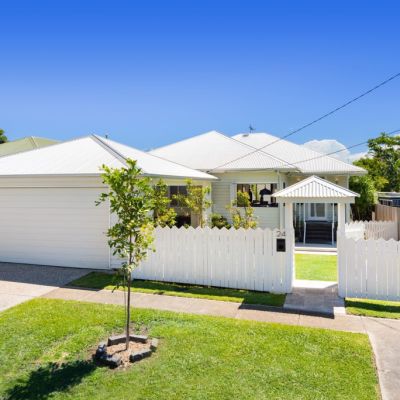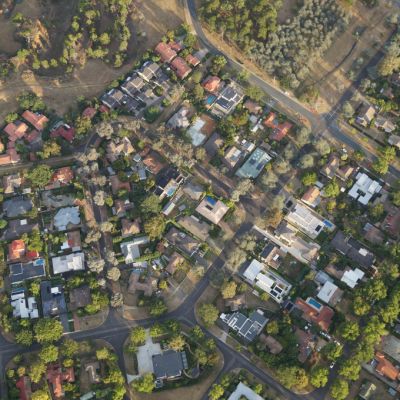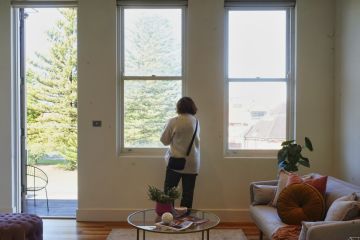'Pure electioneering': First-home buyer help will increase property prices, experts warn
Housing experts have criticised the Federal Government’s failure to seriously address housing affordability in the Budget, warning its measures will push up prices and do not help low-income households.
The Morrison government’s last Budget before the federal election expanded the Home Guarantee Scheme (formerly known as First-Home Loan Deposit Scheme) to 50,000 places a year for the next three years, allowing first-home buyers, single parents and regional Australians to get into the property market with as little a deposit of two or five per cent.
But experts say the extension of the scheme does little more than increase property prices, revealing a failure to address structural issues such as building the half a million homes needed to meet the chronic shortage of supply in the country.

Their comments come as Prime Minister Scott Morrison was asked yesterday why the Budget offered no assistance targeted at renters, who have seen costs rise, particularly in regional areas.
Mr Morrison said the Budget was “about Australians getting into homes”.
“The best way to support people who are renting a house is to help them buy a house,” Mr Morrison told Channel 9.
“People who are buying houses are renters, and ensuring that renters can buy their own home and get the security of home ownership, that was one of the key promises of this budget.”
RMIT University’s emeritus professor of environment and planning Michael Buxton said the Budget measure was “pure electioneering” at the expense of new home buyers and more affordable housing.
“Every time the government announces assistance packages for home buyers it just goes on to the price of housing because developers simply raise the price of the house and land packages they are selling,” he said.
“All these home buyer grants do is stimulate demand, which increases pressure on the supply of houses and prices of housing products.
“Governments know this. But they get a free kick just before the election, so they keep on making the same mistake and adding significantly to the price of housing in the longer term.”

Independent economist Saul Eslake said schemes that purportedly help first-home buyers, like the First Home Guarantee, made little sense in addressing affordability.
“Anything that allows people to spend more on housing results in more expensive housing. We have more than 60 years of history to support that,” Mr Eslake said.
“I don’t think it’s any coincidence that Australian homeownership rates peaked after that first scheme was introduced and have been going down ever since.”
He believed the Federal Government cared little about actually improving housing affordability.
“For all the crocodile tears politicians shed for aspiring first-home buyers … the reality is there aren’t many of them compared with the vastly greater number … who own one property who benefit from rising property prices.
“The point is, given that politicians do appear to be so concerned, why do they keep doing things that make it worse for [first-home buyers]?”
Mr Eslake also raised concerns the government was increasing a scheme that allows first-home buyers to take out a home loan “on wafer-thin margins” at a time interest rates are expected to rise, risking negative equity for the individuals and potentially calling on those guarantees for the government.
“You might have thought that someone in Treasury would have advised them against it. Is it really a smart idea to encourage people with limited financial means to borrow on limited equity, especially after house prices went up an enormous amount and interest rates are about to start going up?”

RateCity modelling found if someone bought in Sydney using the scheme at the end of this year, they could potentially find their equity, which started at 5 per cent, drop to -6 per cent by the end of 2024, based on Westpac forecasts of a fall in property prices.
University of Sydney professor of urban and regional planning Nicole Gurran said the Budget announcement was nothing more than a symbolic measure.
“Unfortunately simply guaranteeing ever larger home loans is almost exactly the opposite of what you’d be doing if you want to extend homeownership in Australia,” she said.
“It’s not even targeted towards new supply.”
She said it was a lost opportunity that there were no increases to Commonwealth Rent Assistance, which helps low-income renters in the private market or community housing.
“That could have really addressed cost of living pressures. It’s a real insult, particularly the ongoing subsidy to landlords in the form of negative gearing.”
The Grattan Institute’s economic policy program director Brendan Coates said the scheme was a double-edged sword.
“You’re solving the deposit hurdle, which is a big problem for many young Australians… the challenge is it’s a big expansion of the scheme, so it is likely to put upwards pressure on price,” he said, adding that it only helps those who are already likely to enter the market.
“It’s a real insult, particularly the ongoing subsidy to landlords in the form of negative gearing.” – Professor Nicole Gurran
With a pre-tax salary of $125,000 for single applicants and $200,000 for couples, the income thresholds were too high as well, he said, capturing between 80 and 95 per cent of working age Australians.
He said ultimately the Budget highlighted the government’s lack of appetite for real housing affordability reforms.
“It reflects our diminished ambitions for affordable housing. It’s clearly a problem because politicians keep announcing policies that are purported to solve the problem. The issue is they’re not taking tough decisions that they need to make in the long term,” he said, suggesting that tackling capital gains tax and negative gearing would be one measure.
“If a first-home buyer is to win then somebody has to lose and that means prices have to go lower, which obviously hurts those who already own property and that is a political reality.”
Housing Minister Michael Sukkar said in a statement that 60,000 Australians had already been supported into home ownership under the Home Guarantee Scheme.
“We want to help even more Australians into their first home or a home that they’ve built for their family, which is why we are expanding the Scheme,” he said.
“The Government also expects to spend $5 billion on Commonwealth Rent Assistance and is working jointly with the states and territories to improve housing outcomes as a priority under the $1.6 billion a year National Housing and Homelessness Agreement, as part of an expected Commonwealth housing spend of $9 billion in 2021-22.”
This article first appeared on Sydney Morning Herald.
We recommend
States
Capital Cities
Capital Cities - Rentals
Popular Areas
Allhomes
More










